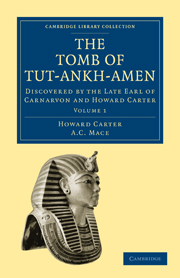Book contents
- Frontmatter
- Preface
- Contents
- LIST OF PLATES
- INTRODUCTION. BIOGRAPHICAL SKETCH OF THE LATE LORD CARNARVON
- CHAPTER 1 THE KING AND THE QUEEN
- CHAPTER 2 THE VALLEY AND THE TOMB
- CHAPTER 3 THE VALLEY IN MODERN TIMES
- CHAPTER 4 OUR PREFATORY WORK AT THEBES
- CHAPTER 5 THE FINDING OF THE TOMB
- CHAPTER 6 A PRELIMINARY INVESTIGATION
- CHAPTER 7 A SURVEY OF THE ANTECAMBER
- CHAPTER 8 CLEARING THE ANTECHAMBER
- CHAPTER 9 VISITORS AND THE PRESS
- CHAPTER 10 WORK IN THE LABORATORY
- CHAPTER 11 THE OPENING OF THE SEALED DOOR
- APPENDIX
- INDEX
- Plate section
- Plate section
CHAPTER 2 - THE VALLEY AND THE TOMB
Published online by Cambridge University Press: 07 October 2011
- Frontmatter
- Preface
- Contents
- LIST OF PLATES
- INTRODUCTION. BIOGRAPHICAL SKETCH OF THE LATE LORD CARNARVON
- CHAPTER 1 THE KING AND THE QUEEN
- CHAPTER 2 THE VALLEY AND THE TOMB
- CHAPTER 3 THE VALLEY IN MODERN TIMES
- CHAPTER 4 OUR PREFATORY WORK AT THEBES
- CHAPTER 5 THE FINDING OF THE TOMB
- CHAPTER 6 A PRELIMINARY INVESTIGATION
- CHAPTER 7 A SURVEY OF THE ANTECAMBER
- CHAPTER 8 CLEARING THE ANTECHAMBER
- CHAPTER 9 VISITORS AND THE PRESS
- CHAPTER 10 WORK IN THE LABORATORY
- CHAPTER 11 THE OPENING OF THE SEALED DOOR
- APPENDIX
- INDEX
- Plate section
- Plate section
Summary
The Valley of the Tombs of the Kings—the very name is full of romance, and of all Egypt's wonders there is none, I suppose, that makes a more instant appeal to the imagination. Here, in this lonely valley-head, remote from every sound of life, with the “Horn,” the highest peak in the Theban hills, standing sentinel like a natural pyramid above them, lay thirty or more kings, among them the greatest Egypt ever knew. Thirty were buried here. Now, probably, but two remain —Amen-hetep II—whose mummy may be seen by the curious lying in his sarcophagus—and Tut-ankh-Amen, who still remains intact beneath his golden shrine. There, when the claims of science have been satisfied, we hope to leave him lying.
I do not propose to attempt a word picture of The Valley itself—that has been done too often in the past few months. I would like, however, to devote a certain amount of time to its history, for that is essential to a proper understanding of our present tomb.
Tucked away in a corner at the extreme end of The Valley, half concealed by a projecting bastion of rock, lies the entrance to a very unostentatious tomb. It is easily overlooked and rarely visited, but it has a very special interest as being the first ever constructed in The Valley. More than that: it is notable as an experiment in a new theory of tomb design.
- Type
- Chapter
- Information
- The Tomb of Tut-Ankh-AmenDiscovered by the Late Earl of Carnarvon and Howard Carter, pp. 50 - 62Publisher: Cambridge University PressPrint publication year: 2010First published in: 1923



